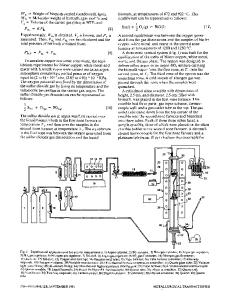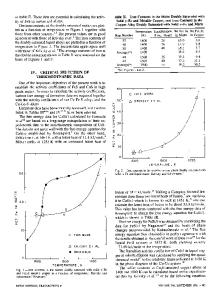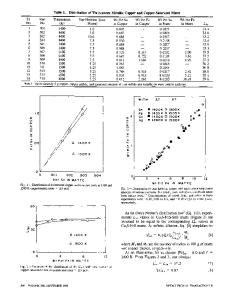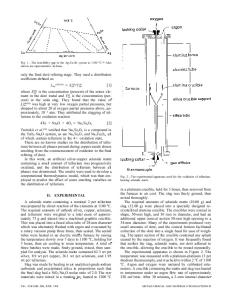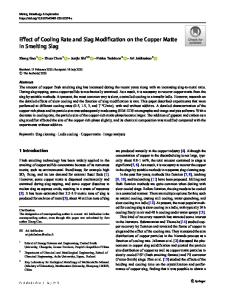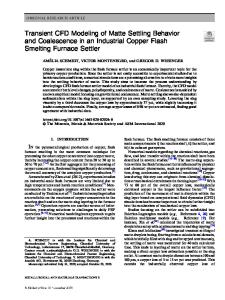Entrainment behavior of copper and copper matte in copper smelting operations
- PDF / 979,885 Bytes
- 9 Pages / 603.28 x 783.28 pts Page_size
- 51 Downloads / 405 Views
I.
INTRODUCTION
M E C H A N I C A L L Y entrained matte or metal droplets in slag originate from a variety of sources such as (1) converter slag returned to the smelting furnace; (2) solid or liquid sulfide from the furnace charge, sliding from unsubmerged regions of the furnace onto the slag and forming a fine dispersion on the slag surface; (3) precipitation of copper from slag due to temperature gradients within the furnace; (4) sulfur dioxide gas produced in the matte phase dispersing the matte into the slag as the gas crosses the matte-slag interface; and (5) attachment of matte or metal droplets to solid magnetite particles present in the slag phase which hinder their settling. The particular interest of this study is the mechanism of droplet entrainment which results from rising gas bubbles. Depending on the operating conditions, gas bubbles entering the slag phase may float the dispersed droplets away from the matte-slag interface. The ability of gas bubbles to pick up matte droplets is governed by the surface and interfacial tension of the copper, matte, and slag system. Figure 1 shows the three different possible situations that may develop. Minto and Davenport ul suggested that case a will occur only if the spreading coefficient as defined by Harkins t21 is positive. The spreading coefficient is defined as if) = ~/s/g
-
-
'Ym/g
- -
"Yrn/s
if the flotation coefficient is greater than zero. The flotation coefficient is defined as m ~ "}ts/g -- 7m/g -1- 'Ymls
Case c will take place only if the flotation coefficient is less than zero. Conochie and Robertson t31 developed a ternary interfacial energy diagram for the prediction of the flotation behavior of the entrained phase. Their approach differs from that of Minto and Davenport m and is based on the balance of surface and interfacial tension forces acting on a droplet resting on a fluid-fluid interface such as the one shown in Figure 2. From such consideration, they obtained the following equations: %lg = yml~ cos 0 + 7,./~ cos q~
l -X-
Y= Ycos0+Xcosq~
yr,/~ sin 0 = "~m/ssin q~
Ysin 0 = X s i n
[4a]
p
[4b]
when
x
=
3,,./,
[5]
"/./8
[6]
2,
y_
~ 7 ~/g
[7]
"~ = ~/s/g -~- ~lm/g -~- ~lrn/s
[8]
Z-
where E
METALLURGICAL TRANSACTIONS B
[3b]
Thu s,
where %/g = slag surface tension; 7m/~ = matte surface tension; and 3',./, = matte-slag interfacial tension.
S.W. IP, Graduate Student, and J.M. TOGURI, Professor, are with the Department of Metallurgy and Materials Science, University of Toronto, Toronto, ON M5S 1A4, Canada. Manuscript submitted May 17, 1991.
[3a]
Thus,
[t]
Flotation of droplets by gas bubbles (case b) will occur
[2]
and X+
Y+Z
= 1
[91
VOLUME 23B, JUNE 1992--303
Details concerning the construction of the ternary interfacial energy diagram from the above equations can be obtained from Reference 3.
II.
EXPERIMENTAL
The sessile drop technique was adopted for surface and interfacial tension measurements. Images of the drops were taken radiographically using the experimental setup shown in Figure 3. Basicall
Data Loading...


